
Wine Culture and Information since 2002 - Volume 22
 Wine Culture and Information since 2002 - Volume 22 |
|
Contrasts of Lago di Caldaro Classico Superiore and Campidano di Terralba |
|
Bovale SuperioreTwo interesting wines, significant representatives of their lands, produced with equally representative grapes of Trentino-Alto Adige and Sardinia, rich in personality and character. This month's tasting by contrast compares two very different and distant grapes and wines. Not only from a geographical point of view – the two wines are produced in Trentino-Alto Adige and Sardinia – but also from the ampelographic and sensorial point of view. Both regions offer a wide range of grapes and wines, often produced with native varieties, all characterized by strong personality and character. The ampelographic heritage of these two regions is rich in both white and red grape varieties and, although here are also found the so-called international grapes, particularly in Trentino-Alto Adige, the identity of the autochthonous varieties of the two territories is well represented in their wines. In this month's tasting by contrast we are going to examine native red varieties of Trentino-Alto Adige and Sardinia. In fact, in our glasses we will pour wines produced in these regions belonging to territories with Denominazione d'Origine Controllata (Controlled Denomination of Origin, DOC) specifically, Lago di Caldaro Classico Superiore for Trentino-Alto Adige, Campidano di Terralba Bovale Superiore for Sardinia. The wines of Lago di Caldaro appellation are produced, in accordance with its production disciplinary, with the Schiava variety, even though, in this case, it is better to say with Schiava grapes. In fact, it should be noted this term defines three distinct varieties, all of which are allowed for the production of Lago di Caldaro wine. Campidano di Terralba Bovale Superiore, on the other hand, has as its protagonist one of the most interesting grapes of Sardinia – Bovale – capable of producing wines of considerable value and personality. Schiava and Bovale grapes are decidedly different varieties and their wines are equally different from every point of view, both enological and sensorial. In the first case, the finesse and elegance of the wines of Lago di Caldaro and the Schiava grapes, in the second case the power and character of Bovale expressed in the wines of what is the most significant area of Sardinia for wines produced with this grape: Campidano di Terralba in the provinces of Oristano and Southern Sardinia. It will therefore be a very interesting tasting by contrast, in which we will have the opportunity to compare two decidedly different and distant styles.
|
|
The wine-growing area of Lago di Caldaro (Lake Caldaro) is one of the main representative ones of Trentino-Alto Adige wine production. This important area with Denominazione d'Origine Controllata (Denomination of Controlled Origin, DOC) is located around the lake of the same name and extends into the territories of the provinces of Bolzano and Trento, has a long history and here wines were produced as early as 500 BC. In this appellation the queen grape is Schiava, however – in this case – it is better to talk about the family of the Schiava grapes as it includes three distinct members: Schiava Grossa, Schiava Gentile and Schiava Grigia. Due to the bilingualism in force in South Tyrol (Alto Adige), this appellation is also known by the German name of Kalterersee, whereas – for the same reason – Schiava grapes are also known as Vernatsch, more specifically and respectively Großvernatsch, Kleinvernatsch and Grauvernatsch. For the sake of completeness, it should be noted that Schiava Gentile is also called Schiava Piccola (Small Schiava, Kleinvernatsch) or Schiava Media (Medium Schiava, Mittlerer Vernatsch). As for Schiava Grigia, it is usually considered as a distinct variety, despite its enological and organoleptic similarities with the other members of the “Schiava” family. The origin of the name is not clear yet, since for some it derives from the method used to cultivate this vine in the past, that is tied to trees and poles (therefore, so to speak “schiavizzate”, enslaved), but also for the drastic pruning carried out with the aim of obtaining greater vigor and therefore better quality of the grapes. Furthermore, for others it would derive from the characteristic low-stump cultivation and “enslaved” in rows. Another theory would be the Slavic origin, introduced in these lands during the Lombard invasions, therefore Italianized in “schiava”. In accordance with its production disciplinary, this wine is produced for a minimum of 85% of Schiava Grossa, Schiava Gentile and Schiava Grigia grapes, alone or together. The remaining 15% can be represented by varieties allowed to cultivation in Trentino-Alto Adige. The disciplinary of Lago di Caldaro also provide for the styles riserva, scelto, classico, classico riserva, classico superiore, classico superiore riserva, scelto classico, scelto classico riserva, scelto classico superiore and scelto classico superiore riserva. The “riserva” styles must age for a minimum of two years, an operation often carried out in wooden containers.
|
||||
|
Sardinia is among the regions of Italy to boast the richest heritage of native varieties and, among them, a position of absolute importance certainly belongs to Bovale grape. Once used as a blending grape to give fuller structure to the wines of the island, in particular, to those produced with Cannonau and Monica grapes, today it is widely recognized as a grape of absolute importance in the rich viticultural panorama of Sardinia. Bovale finds its most significant expression in the Denominazione d'Origine Controllata (Denomination of Controlled Origin, DOC) of Campidano di Terralba – or simply, Terralba – which territory extends between the provinces of Oristano and Southern Sardinia. In fact, it must be said that, despite Bovale is widespread throughout the region, Campidano di Terralba area is the only denomination in Sardinia providing for the use of Bovale as the prevalent variety. In accordance with its production disciplinary, in fact, Campidano di Terralba is produced with Bovale Sardo and/or Bovale Grande for at least 85%, while the remaining part can be made up of red berried grapes allowed for cultivation in Sardinia. In this regard, it must be said that producers tend to make the wines of this territory with 100% Bovale, in particular to enhance the interesting qualities this grape expresses in this land. As far as history is concerned, the origin of Bovale is still unclear and uncertain today. It is supposed they are varieties introduced from Spain during the Aragonese dominion, distinguishing themselves in two specific varieties: Bovale Sardo – or simply, Bovale – and Bovale Grande. Genetic investigations on these two varieties – despite their name – have shown there is no relationship between them and therefore they are distinct varieties. It was also possible to highlight a certain similarity of Bovale Sardo with Cagnulari and Graciano varieties, while Bovale Grande seems to share characteristics of Carignano, Cariñena and Mazuela, proving, in this sense, their supposed Spanish origin. In accordance with the production disciplinary, Campidano di Terralba includes Superiore and Riserva styles, the latter aged for at least two years, a practice which is often carried out in wooden containers.
|
Before starting this month's tasting by contrast, let's find the two bottles we will pour into the glasses. In this regard it must be said the search for Lago di Caldaro Classico Superiore is relatively simple since it is a wine enjoying both good production and distribution. The purchase of Campidano di Terralba Bovale Superiore can be certainly more difficult, because – despite its enological prestige in the viticultural panorama of Sardinia – it is not very present on the shelves of large retailers, however a good wine shop will certainly be successful in finding a bottle of this interesting Sardinian wine. In both cases we will have to pay attention to the composition, since the respective disciplinary provide for the use of their primary grapes for a minimum of 85%. We will therefore make sure Lago di Caldaro Classico Superiore is produced exclusively with the Schiava varieties, whereas Campidano di Terralba Bovale Superiore with the homonymous variety alone. The two bottles belong to the most recent vintage and the wines are poured into tasting glasses at a temperature of 18 °C (65 °F). Let's pour Lago di Caldaro Classico Superiore and Campidano di Terralba Bovale Superiore into our glasses and start this month's tasting by contrast. The first wine we will examine is the one from Trentino-Alto Adige, therefore, by tilting the glass over a white surface – a sheet of paper is enough – we observe the base in order to evaluate its color. We can observe a brilliant and intense ruby red color, furthermore – by placing an object in contrast between the glass and the white surface – we can notice a moderate transparency such as to allow the vision of the object. Let's now focus our attention towards the opening of the glass, where the thickness of the wine becomes thin, and let's evaluate the nuances: Lago di Caldaro Classico Superiore confirms the ruby red color. Let's now pass to the evaluation of the appearance of Campidano di Terralba Bovale Superiore and, just like in the previous wine, we tilt the glass over the white surface. The color of the Sardinian wine is ruby red, decidedly more intense and darker than the Trentino-Alto Adige wine. The transparency of Bovale, compared to the previous wine, is decidedly lower and the object placed in contrast is hardly visible. The nuance of Campidano di Terralba Bovale Superiore confirms the ruby red color. The aromas expressed by the wines produced with Schiava and Bovale grapes differ substantially in several aspects. Wines produced with Schiava grapes – such as Lago di Caldaro – are mainly characterized by the finesse and elegance of their aromas, in particular by the sensations of red pulp fruits and flowers. Among the main aromas in wines produced with Schiava grapes we find, as regards the sensations of fruits, the aromas of cherry, raspberry, plum, strawberry and blueberry. Furthermore, wines produced with Schiava grapes, and therefore also Lago di Caldaro, are often characterized by a pleasing almond scent. The world of flowers we find in these wines is mainly represented by cyclamen and violet. The olfactory profile of wines produced with Bovale is quite different and decidedly more powerful. The character, compared to the one expressed by Schiava, is decidedly more full and powerful, in which we recognize, as regards the sensations of fruits, aromas of black cherry, plum, blackberry and blueberry. The main floral perception of wines produced with Bovale is violet. Let's resume our tasting by contrast and proceed with the analysis of the olfactory profiles of Lago di Caldaro Classico Superiore and Campidano di Terralba Bovale Superiore. The first wine we examine, just like in the previous phase, is the one produced in Trentino-Alto Adige. By holding the glass in vertical position and without swirling, let's do the first smell in order to evaluate the opening, that is the identifying and primary aromas. In Lago di Caldaro Classico Superiore can be immediately recognized aromas of cherry, raspberry and plum, promptly followed by the scent of cyclamen and violet. After having swirled the glass, the Trentino-Alto Adige wine continues to give aromas reminiscent of fruit and, in particular, strawberry and blueberry. Furthermore, it can be perceived, clear and intense, the pleasing scent of almond. Let's now move on to the evaluation of the opening of Campidano di Terralba Bovale Superiore, proceeding with the first smell and holding the glass in vertical position, without swirling. From the glass are perceived intense aromas of black cherry, blueberry and blackberry, followed by the pleasing scent of violet. After having swirled the glass, the profile of the Sardinian wine is completed with plum, sometimes accompanied by raspberry and black currant. The evaluation of the gustatory profiles is certainly the phase that highlights the greatest differences between Lago di Caldaro Classico Superiore and Campidano di Terralba Bovale Superiore. Let's start with the evaluation of the attack, that is the initial gustatory sensations we perceive in the wine after the first sip. Just like in the previous phases, we proceed with the evaluation of Lago di Caldaro Classico Superiore, and we therefore take a sip of this wine. In the mouth is immediately perceived a pleasing and moderate astringency, followed by the equally pleasing crispness given by acidity. The wine however has a very good balance thanks to the effect of alcohol. In the mouth we perceive good finesse and elegance, as well as flavors of cherry, raspberry and plum. Let's now pass to the evaluation of the attack of Campidano di Terralba Bovale Superiore by taking a sip of this wine from the glass. The gustatory difference with the Trentino-Alto Adige wine is evident: the attack of the Sardinian wine is decidedly more robust and also the astringency is more intense. Moreover, the perception of roundness and the effect of alcohol are both higher, while the crispness is decidedly lower. Finally, we can also perceive flavors of black cherry, blueberry and blackberry. We have now reached the final phase of our tasting by contrast, consisting in the evaluation of the final sensations the wines leave in the mouth after swallowing, in particular the taste-olfactory persistence. The finish of Lago di Caldaro Classico Superiore is intense and in the mouth we continue to perceive pleasing sensations of crispness and moderate astringency, well supported by good elegance and finesse. In addition, we continue to perceive flavors of cherry, raspberry, plum and strawberry, sometimes almond as well. The sensorial differences of the two wines also continue in the final phase of the tasting. Campidano di Terralba Bovale Superiore – also characterized by good persistence – in fact leaves in the mouth a sensation of a fuller structure and astringency, with a more pronounced roundness and crispness of less intensity than the previous wine. In the mouth, finally, the Sardinian wine leaves clean and intense flavors of black cherry, blackberry and plum, often combined with blueberry.
|
||||||||
Wines of the Month |
|
|
|
Score legend Prices are to be considered as indicative. Prices may vary according to the country or the shop where wines are bought |

|
|
Demetra Pinot Bianco Brut Nature |
|
| Mirabella (Lombardy, Italy) | |
 Pinot Bianco Pinot Bianco | |
| Price: € 26.00 | Score: |
 Pale straw yellow and nuances of straw yellow, very transparent, fine
and persistent perlage. Pale straw yellow and nuances of straw yellow, very transparent, fine
and persistent perlage.
 Intense, clean, pleasing, refined and elegant, starts with hints of
apple, plum and bread crust followed by aromas of hawthorn, chamomile,
broom, pineapple, pear, candied fruits, citron, honey, praline, linden and
mineral. Intense, clean, pleasing, refined and elegant, starts with hints of
apple, plum and bread crust followed by aromas of hawthorn, chamomile,
broom, pineapple, pear, candied fruits, citron, honey, praline, linden and
mineral.
 Effervescent and crisp attack, however balanced by alcohol, good body,
intense flavors, agreeable. Effervescent and crisp attack, however balanced by alcohol, good body,
intense flavors, agreeable.
 Persistent finish with flavors of apple, plum and praline. Persistent finish with flavors of apple, plum and praline. A small part of the base wine ferments in barrique. Refermeted in
bottle and aged on its lees for at least 24 months. A small part of the base wine ferments in barrique. Refermeted in
bottle and aged on its lees for at least 24 months.
|
|
 Pasta with fish, Stewed white meat, Roasted fish, Fish soups Pasta with fish, Stewed white meat, Roasted fish, Fish soups |
|

|
|
Franciacorta Brut Nature Demetra 2016 |
|
| Mirabella (Lombardy, Italy) | |
 Chardonnay (70%), Pinot Nero (20%), Pinot Bianco (10%) Chardonnay (70%), Pinot Nero (20%), Pinot Bianco (10%) | |
| Price: € 27.00 | Score: |
 Pale straw yellow and nuances of straw yellow, very transparent, fine
and persistent perlage. Pale straw yellow and nuances of straw yellow, very transparent, fine
and persistent perlage.
 Intense, clean, pleasing, refined and elegant, starts with hints of
banana, plum and bread crust followed by aromas of acacia, hawthorn,
citron, apple, pear, grapefruit, hazelnut, croissant, butter, praline and
honey. Intense, clean, pleasing, refined and elegant, starts with hints of
banana, plum and bread crust followed by aromas of acacia, hawthorn,
citron, apple, pear, grapefruit, hazelnut, croissant, butter, praline and
honey.
 Effervescent and crisp attack, however balanced by alcohol, good body,
intense flavors, agreeable. Effervescent and crisp attack, however balanced by alcohol, good body,
intense flavors, agreeable.
 Persistent finish with flavors of banana, plum and citron. Persistent finish with flavors of banana, plum and citron. A small part of the base wine ferments in barrique. Refermented in
bottle and aged in its lees for at least 60 months. A small part of the base wine ferments in barrique. Refermented in
bottle and aged in its lees for at least 60 months.
|
|
 Pasta with fish, Roasted fish, Roasted white meat, Fish soups, Mushroom soups Pasta with fish, Roasted fish, Roasted white meat, Fish soups, Mushroom soups |
|
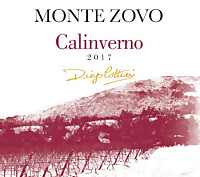
|
|
Calinverno 2017 |
|
| Monte Zovo (Veneto, Italy) | |
 Corvina, Corvinone (70%), Rondinella (20%), Cabernet Sauvignon (5%), Croatina (5%) Corvina, Corvinone (70%), Rondinella (20%), Cabernet Sauvignon (5%), Croatina (5%) | |
| Price: € 23.90 | Score: |
 Deep ruby red and nuances of garnet red, little transparency. Deep ruby red and nuances of garnet red, little transparency. Intense, clean, pleasing, refined and elegant, starts with hints of
plum, black cherry and blackberry followed by aromas of dried violet,
blueberry, cocoa, tobacco, licorice, leather, mace, vanilla and menthol. Intense, clean, pleasing, refined and elegant, starts with hints of
plum, black cherry and blackberry followed by aromas of dried violet,
blueberry, cocoa, tobacco, licorice, leather, mace, vanilla and menthol.
 Properly tannic attack and however balanced by alcohol, full body,
intense flavors, pleasing roundness. Properly tannic attack and however balanced by alcohol, full body,
intense flavors, pleasing roundness.
 Persistent finish with flavors of plum, black cherry and blackberry. Persistent finish with flavors of plum, black cherry and blackberry. 24 months in barrique and cask, 12 months in bottle. 24 months in barrique and cask, 12 months in bottle. |
|
 Game, Roasted meat, Stewed and braised meat, Hard cheese Game, Roasted meat, Stewed and braised meat, Hard cheese |
|
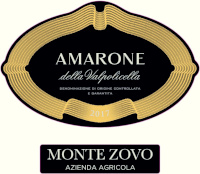
|
|
Amarone della Valpolicella 2017 |
|
| Monte Zovo (Veneto, Italy) | |
 Corvina (60%), Corvinone (30%), Rondinella (10%) Corvina (60%), Corvinone (30%), Rondinella (10%) | |
| Price: € 38.60 | Score: |
 Deep ruby red and nuances of garnet red, little transparency. Deep ruby red and nuances of garnet red, little transparency. Intense, clean, pleasing, refined and elegant, starts with hints of
blackberry, plum and dried violet followed by aromas of black cherry
macerated in alcohol, blueberry, chocolate, tamarind, tobacco, cinnamon,
licorice, leather, mace, caramel, vanilla and menthol. Intense, clean, pleasing, refined and elegant, starts with hints of
blackberry, plum and dried violet followed by aromas of black cherry
macerated in alcohol, blueberry, chocolate, tamarind, tobacco, cinnamon,
licorice, leather, mace, caramel, vanilla and menthol.
 Properly tannic attack and however balanced by alcohol, full body,
intense flavors, pleasing roundness. Properly tannic attack and however balanced by alcohol, full body,
intense flavors, pleasing roundness.
 Very persistent finish with long flavors of blackberry, plum and black
cherry macerated in alcohol. Very persistent finish with long flavors of blackberry, plum and black
cherry macerated in alcohol.
 24 months in cask and barrique, 6 months in steel tanks, at least 12
months in bottle. 24 months in cask and barrique, 6 months in steel tanks, at least 12
months in bottle.
|
|
 Game, Roasted meat, Stewed and braised meat with mushrooms, Hard cheese Game, Roasted meat, Stewed and braised meat with mushrooms, Hard cheese |
|
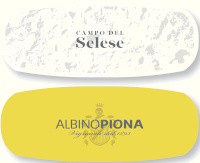
|
|
Bianco di Custoza Superiore Campo del Selese 2020 |
|
| Albino Piona (Veneto, Italy) | |
 Garganega (40%), Trebbiano di Soave (30%), Trebbianello di Soave (15%), Pinot Bianco, Incrocio Manzoni 6.0.13 (15%) Garganega (40%), Trebbiano di Soave (30%), Trebbianello di Soave (15%), Pinot Bianco, Incrocio Manzoni 6.0.13 (15%) | |
| Price: € 20.00 | Score: |
 Brilliant straw yellow and nuances of straw yellow, very transparent. Brilliant straw yellow and nuances of straw yellow, very transparent. Intense, clean, pleasing, refined and elegant, starts with hints of
apple, plum and citrus fruits followed by aromas of hawthorn, broom,
pineapple, pear, medlar, banana, honey, almond, vanilla and mineral. Intense, clean, pleasing, refined and elegant, starts with hints of
apple, plum and citrus fruits followed by aromas of hawthorn, broom,
pineapple, pear, medlar, banana, honey, almond, vanilla and mineral.
 Crisp attack and however balanced by alcohol, good body, intense
flavors, pleasing roundness. Crisp attack and however balanced by alcohol, good body, intense
flavors, pleasing roundness.
 Persistent finish with flavors of apple, plum and pineapple. Persistent finish with flavors of apple, plum and pineapple. Part of the Garganega ferments in barrique. 12 months in steel tanks. Part of the Garganega ferments in barrique. 12 months in steel tanks. |
|
 Stuffed pasta with mushrooms, Roasted white meat, Roasted fish, Legume soups Stuffed pasta with mushrooms, Roasted white meat, Roasted fish, Legume soups |
|
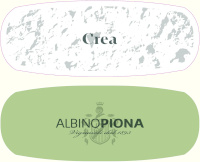
|
|
Bianco di Custoza Crea 2019 |
|
| Albino Piona (Veneto, Italy) | |
 Garganega (40%), Trebbiano di Soave (30%), Trebbianello di Soave (15%), Incrocio Manzoni 6.0.13 (15%) Garganega (40%), Trebbiano di Soave (30%), Trebbianello di Soave (15%), Incrocio Manzoni 6.0.13 (15%) | |
| Price: € 22.00 | Score: |
 Intense golden yellow and nuances of golden yellow, very transparent. Intense golden yellow and nuances of golden yellow, very transparent. Intense, clean, pleasing, refined and elegant, starts with hints of
apple, plum and peach followed by aromas of hawthorn, broom, pineapple,
pear, medlar, grapefruit, citrus fruit peel, honey, almond and vanilla. Intense, clean, pleasing, refined and elegant, starts with hints of
apple, plum and peach followed by aromas of hawthorn, broom, pineapple,
pear, medlar, grapefruit, citrus fruit peel, honey, almond and vanilla.
 Crisp attack and however balanced by alcohol, good body, intense
flavors, pleasing roundness. Crisp attack and however balanced by alcohol, good body, intense
flavors, pleasing roundness.
 Persistent finish with flavors of plum, apple and peach. Persistent finish with flavors of plum, apple and peach. 16 months in barrique. 16 months in barrique. |
|
 Stuffed pasta with mushrooms, Roasted white meat, Roasted fish, Stewed white meat, Cheese Stuffed pasta with mushrooms, Roasted white meat, Roasted fish, Stewed white meat, Cheese |
|
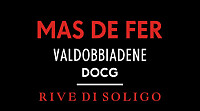
|
|
Valdobbiadene Extra Dry Rive di Soligo Mas de Fer 2021 |
|
| Andreola (Veneto, Italy) | |
 Glera Glera | |
| Price: € 11.80 | Score: |
 Intense greenish yellow and nuances of greenish yellow, very
transparent, fine and persistent perlage. Intense greenish yellow and nuances of greenish yellow, very
transparent, fine and persistent perlage.
 Intense, clean, pleasing, refined and elegant, starts with hints of
pear, apricot and wisteria followed by aromas of acacia, hawthorn, broom,
tangerine, apple, pineapple, mango, melon, fern and almond. Intense, clean, pleasing, refined and elegant, starts with hints of
pear, apricot and wisteria followed by aromas of acacia, hawthorn, broom,
tangerine, apple, pineapple, mango, melon, fern and almond.
 Effervescent and crisp attack, however balanced by alcohol, light body,
intense flavors, pleasing sweetness. Effervescent and crisp attack, however balanced by alcohol, light body,
intense flavors, pleasing sweetness.
 Persistent finish with flavors of pear, apricot and tangerine. Persistent finish with flavors of pear, apricot and tangerine. Produced with the Charmat method. Produced with the Charmat method. |
|
 Aperitifs, Crustacean and vegetable appetizers, Risotto with crustaceans and vegetables, Sauteed fish Aperitifs, Crustacean and vegetable appetizers, Risotto with crustaceans and vegetables, Sauteed fish |
|
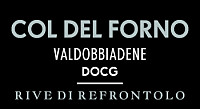
|
|
Valdobbiadene Brut Rive del Refrontolo Col del Forno 2021 |
|
| Andreola (Veneto, Italy) | |
 Glera Glera | |
| Price: € 11.80 | Score: |
 Intense greenish yellow and nuances of greenish yellow, very
transparent, fine and persistent perlage. Intense greenish yellow and nuances of greenish yellow, very
transparent, fine and persistent perlage.
 Intense, clean, pleasing, refined and elegant, starts with hints of
pear, peach and wisteria followed by aromas of acacia, broom, green apple,
tangerine, kiwi, banana, pineapple, mango, medlar and dill. Intense, clean, pleasing, refined and elegant, starts with hints of
pear, peach and wisteria followed by aromas of acacia, broom, green apple,
tangerine, kiwi, banana, pineapple, mango, medlar and dill.
 Effervescent and crisp attack, however balanced by alcohol, light body,
intense flavors, agreeable. Effervescent and crisp attack, however balanced by alcohol, light body,
intense flavors, agreeable.
 Very persistent finish with long flavors of pear, peach and green
apple. Very persistent finish with long flavors of pear, peach and green
apple.
 Produced with the Charmat method. Produced with the Charmat method. |
|
 Aperitifs, Fish appetizers, Pasta and risotto with fish and crustaceans, Sauteed fish, Dairy products, Eggs Aperitifs, Fish appetizers, Pasta and risotto with fish and crustaceans, Sauteed fish, Dairy products, Eggs |
|
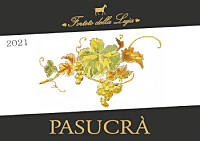
|
|
Piemonte Moscato Secco Pasucrà 2021 |
|
| Forteto della Luja (Piedmont, Italy) | |
 Moscato Bianco Moscato Bianco | |
| Price: € 9.80 | Score: |
 Brilliant golden yellow and nuances of golden yellow, very transparent. Brilliant golden yellow and nuances of golden yellow, very transparent. Intense, clean, pleasing and refined, starts with hints of grape. peach
and white rose followed by aromas of broom, lavender, lychee, pear, apple,
citrus fruits, banana and sage. Intense, clean, pleasing and refined, starts with hints of grape. peach
and white rose followed by aromas of broom, lavender, lychee, pear, apple,
citrus fruits, banana and sage.
 Crisp attack and however balanced by alcohol, good body, intense
flavors, agreeable. Crisp attack and however balanced by alcohol, good body, intense
flavors, agreeable.
 Persistent finish with flavors of grape, peach and lychee. Persistent finish with flavors of grape, peach and lychee. Aged in steel tanks. Aged in steel tanks. |
|
 Pasta and risotto with crustaceans and mushrooms, Broiled crustaceans, Sauteed white meat with mushrooms Pasta and risotto with crustaceans and mushrooms, Broiled crustaceans, Sauteed white meat with mushrooms |
|
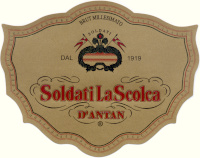
|
|
Soldati La Scolca Brut Millesimato Riserva d'Antan 2010 |
|
| La Scolca (Piedmont, Italy) | |
 Cortese Cortese | |
| Price: € 70.00 | Score: |
 Brilliant golden yellow and nuances of golden yellow, very transparent,
fine and persistent perlage. Brilliant golden yellow and nuances of golden yellow, very transparent,
fine and persistent perlage.
 Intense, clean, pleasing, refined and elegant, starts with hints of
apple, orange and bread crust followed by aromas of hawthorn, broom, pear,
peach, plum, hazelnut, mango, pineapple, almond, honey, croissant and
butter. Intense, clean, pleasing, refined and elegant, starts with hints of
apple, orange and bread crust followed by aromas of hawthorn, broom, pear,
peach, plum, hazelnut, mango, pineapple, almond, honey, croissant and
butter.
 Effervescent and crisp attack, however balanced by alcohol, good body,
intense flavors, agreeable. Effervescent and crisp attack, however balanced by alcohol, good body,
intense flavors, agreeable.
 Very persistent finish with long flavors of apple, orange and almond. Very persistent finish with long flavors of apple, orange and almond. Refermented in bottle and aged in its lees for at about 10 years. Refermented in bottle and aged in its lees for at about 10 years. |
|
 Stuffed pasta with fish and mushrooms, Roasted fish, Roasted white meat, Stewed white meat Stuffed pasta with fish and mushrooms, Roasted fish, Roasted white meat, Stewed white meat |
|
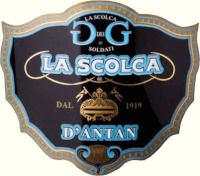
|
|
La Scolca d'Antan 2008 |
|
| La Scolca (Piedmont, Italy) | |
 Cortese Cortese | |
| Price: € 69.00 | Score: |
 Intense straw yellow and nuances of golden yellow, very transparent. Intense straw yellow and nuances of golden yellow, very transparent. Intense, clean, pleasing, refined and elegant, starts with hints of
quince, plum and almond followed by aromas of hawthorn, bread crust,
grapefruit, bergamot, pear jam, linden, walnut husk, honey, croissant,
rosemary, butter and flint. Intense, clean, pleasing, refined and elegant, starts with hints of
quince, plum and almond followed by aromas of hawthorn, bread crust,
grapefruit, bergamot, pear jam, linden, walnut husk, honey, croissant,
rosemary, butter and flint.
 Crisp attack and however balanced by alcohol, good body, intense
flavors, agreeable. Crisp attack and however balanced by alcohol, good body, intense
flavors, agreeable.
 Very persistent finish with flavors of plum, quince and almond. Very persistent finish with flavors of plum, quince and almond. Aged in steel tanks. Aged in steel tanks. |
|
 Stuffed pasta with fish, Roasted white meat, Roasted fish, Mushroom soups, Cheese Stuffed pasta with fish, Roasted white meat, Roasted fish, Mushroom soups, Cheese |
|
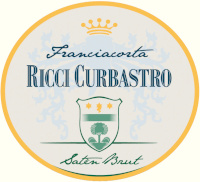
|
|
Franciacorta Satèn Brut 2018 |
|
| Ricci Curbastro (Lombardy, Italy) | |
 Chardonnay Chardonnay | |
| Price: € 30.00 | Score: |
 Pale straw yellow and nuances of straw yellow, very transparent, fine
and persistent perlage. Pale straw yellow and nuances of straw yellow, very transparent, fine
and persistent perlage.
 Intense, clean, pleasing, refined and elegant, starts with hints of
banana, acacia and bread crust followed by aromas of hawthorn, apple,
grapefruit, pear, citron, pineapple, butter, honey, croissant and praline. Intense, clean, pleasing, refined and elegant, starts with hints of
banana, acacia and bread crust followed by aromas of hawthorn, apple,
grapefruit, pear, citron, pineapple, butter, honey, croissant and praline.
 Effervescent and crisp attack, however balanced by alcohol, good body,
intense flavors, agreeable. Effervescent and crisp attack, however balanced by alcohol, good body,
intense flavors, agreeable.
 Persistent finish with flavors of apple, banana and grapefruit. Persistent finish with flavors of apple, banana and grapefruit. Refermented in bottle and aged on its lees for at least 40 months. Refermented in bottle and aged on its lees for at least 40 months. |
|
 Pasta and risotto with fish and crustaceans, Sauteed white meat, Sauteed crustaceans, Roasted fish Pasta and risotto with fish and crustaceans, Sauteed white meat, Sauteed crustaceans, Roasted fish |
|
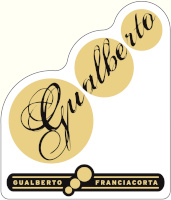
|
|
Franciacorta Dosaggio Zero Gualberto 2012 |
|
| Ricci Curbastro (Lombardy, Italy) | |
 Pinot Nero (65%), Chardonnay (35%) Pinot Nero (65%), Chardonnay (35%) | |
| Price: € 41.00 | Score: |
 Intense straw yellow and nuances of straw yellow, very transparent,
fine and persistent perlage. Intense straw yellow and nuances of straw yellow, very transparent,
fine and persistent perlage.
 Intense, clean, pleasing, refined and elegant, starts with hints of
apple, banana and bread crust followed by aromas of hawthorn, grapefruit,
melon, pineapple, peach, tangerine, honey, croissant, praline, butter,
vanilla and mineral. Intense, clean, pleasing, refined and elegant, starts with hints of
apple, banana and bread crust followed by aromas of hawthorn, grapefruit,
melon, pineapple, peach, tangerine, honey, croissant, praline, butter,
vanilla and mineral.
 Effervescent and crisp attack, however balanced by alcohol, good body,
intense flavors, agreeable. Effervescent and crisp attack, however balanced by alcohol, good body,
intense flavors, agreeable.
 Very persistent finish with long flavors of apple, banana and
grapefruit. Very persistent finish with long flavors of apple, banana and
grapefruit.
 A small part of the base wine ferments in barrique. Refermented in
bottle and aged in its lees for at least 80 months. A small part of the base wine ferments in barrique. Refermented in
bottle and aged in its lees for at least 80 months.
|
|
 Pasta with fish and mushrooms, Roasted fish, Roasted white meat, Stewed fish with mushrooms Pasta with fish and mushrooms, Roasted fish, Roasted white meat, Stewed fish with mushrooms |
|
|
||||||||
|
DiWineTaste Polls
|
| |||||||
Privacy Policy | |||||||


| Copyright © 2002-2024 Antonello Biancalana, DiWineTaste - All rights reserved |
| All rights reserved under international copyright conventions. No part of this publication and of this WEB site may be
reproduced or utilized in any form or by any means, electronic or mechanical, without permission in writing from DiWineTaste. |